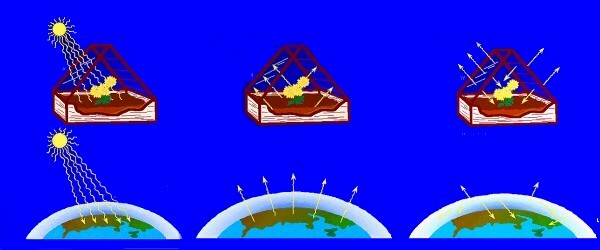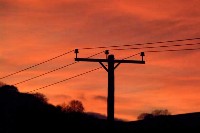 > English > Climate Encyclopaedia > Lower Atmosphere > basics > 2. Greenhouse, light & biosphere > - Greenhouse effect & light
> English > Climate Encyclopaedia > Lower Atmosphere > basics > 2. Greenhouse, light & biosphere > - Greenhouse effect & light
|
Lower AtmosphereBasics |
Light and the greenhouse effectEnergy to power our planet comes from the Sun. But what happens to the sunlight on its way to Earth and what happens to the energy emitted from the surface of the Earth as it travels back into space?
|
The atmosphere has an influence on lightWe learnt in the first unit of this topic that air consists of different gases, particles and water which can either exist in the gas phase or as liquid droplets. During a dust storm, when the sun is pale or on a rainy day, when clouds cover the sky, it's much darker than on a bright clear day without any clouds. But it's not only particles and clouds which affect how much light gets to the surface of the Earth, the gases in the air also influence the amount of sunlight which reaches the ground.
|
|
Energy is in balanceSunlight warms the surface of the Earth. The water in the sea becomes warmer in summer and the streets get so hot in some places that its impossible to walk on them barefoot. Since the earth cannot store this heat forever, the warm Earth sends energy back into space. The sunlight which hits the Earth's surface is made up of high energy ultra-violet and visible radiation. The energy emitted from the surface of the Earth is infra-red or 'longwave radiation' and is less energetic than sunlight.
If the Earth doesn't send back all the energy it receives from the Sun, more and more energy would accumulate on the Earth and it would become hotter and hotter. But this isn't the case. Energy is in balance. Radiation comes from the Sun. We call this radiation light (shown in yellow on the image). Radiation is sent back from the Earth and we call this infrared light or infrared radiation (shown in red).
|
 |
|
2. What happens to radiation from the Sun? Author: Elmar Uherek. |
What happens when solar radiation enters the atmosphere?First, let us look what happens to the sunlight. 1. The Sun is the source of all radiation and energy coming to the Earth from space. The sunlight which reaches the Earth, warms its surface. The Earth sends this warmth back into space as infra-red heat radiation. What happens to this heat radiation? 6. The warm surface of the Earth is a source of infra-red heat radiation to space. We must take all these processes into account if we want to understand our climate. But why do we call it a greenhouse effect?
|
 |
|
3. The greenhouse effect - compare the interaction of light in a greenhouse with that on Earth! Original source: NOAA. |
|
The role of greenhouse gases in the atmosphere can be compared to the role of glass in a greenhouse. The glass lets the sunlight in and the light warms the soil and plants in the greenhouse. These send out heat radiation. When this heat radiation hits the glass, it doesn't pass back through like the sunlight, but is absorbed by the glass. So the glass heats up and this heat goes back into the greenhouse and it gets hotter. This is similar to what greenhouse gases in the atmosphere do. They let the sunlight in, but they don't let the heat radiation from Earth back out into space.
|
About this page:Author: Dr. Elmar Uherek - Max Planck Institute for Chemistry Mainz/Germany
|

